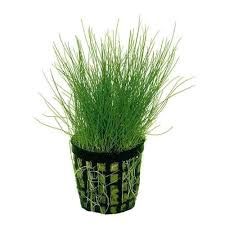Eleocharis parvula 'Dwarf Hairgrass'
Eleocharis parvula – Dwarf Hairgrass
Eleocharis parvula, commonly known as Dwarf Hairgrass, is a popular foreground plant in aquascaping for creating lush, grass-like carpets. Its fine, bright green leaves form a soft, natural meadow effect in the aquarium, providing excellent coverage for small fish and shrimp. Native to Asia, this adaptable plant thrives in well-lit, nutrient-rich environments.
Lighting
-
Moderate to High Lighting: Strong light encourages compact, dense growth. Under low light, Eleocharis parvula grows taller, less dense, and may develop elongated leaves.
Water Parameters
-
Temperature: 20–28 °C; stable mid-range temperatures promote steady growth.
-
pH: 6.0–7.5, tolerates slightly acidic to neutral water conditions.
-
Water Hardness: Soft to moderately hard water (2–12 dGH) is ideal.
Substrate
-
Nutrient-Rich Substrate: Aquasoil or fine gravel enriched with nutrients supports healthy root development.
-
Depth: 5–7.5 cm (2–3 inches) substrate depth allows proper root anchoring and spreading.
CO₂ and Fertilization
-
CO₂: Beneficial for faster growth and denser carpet formation, but not strictly required.
-
Fertilization: Liquid fertilizers and root tabs with nitrogen, potassium, and micronutrients support healthy growth.
Growth and Maintenance
-
Growth Rate: Slow to moderate; spreads via runners forming new shoots along the substrate.
-
Pruning: Trim regularly to maintain a neat, dense carpet and encourage horizontal spreading.
Placement in Aquarium
-
Foreground: Ideal for carpeting the front of the aquarium, adding texture and natural habitat for shrimp and small fish.
Propagation
-
Runners: Propagates naturally by sending out runners that develop into new plants. Can be separated and replanted to speed coverage.
Water Flow and Circulation
-
Moderate Flow: Promotes healthy growth, prevents debris accumulation on leaves, and encourages even nutrient distribution.
Algae Control
-
Prevention: Balanced lighting, nutrients, and regular water changes help minimize algae growth on delicate blades.
Compatibility
-
Community Tank Friendly: Safe for most peaceful fish and invertebrates. Avoid large or digging fish that may uproot plants.
With proper care, Eleocharis parvula will form a dense, lush green carpet, transforming your aquarium into a vibrant, natural foreground.
Interesting Fact: Dwarf Hairgrass adapts its growth to available light and nutrients—under strong light and CO₂, it forms a thick, compact carpet, while in lower light it grows taller and sparser. Its grass-like appearance also provides shelter for small aquatic creatures, enhancing the ecological balance of the tank.

